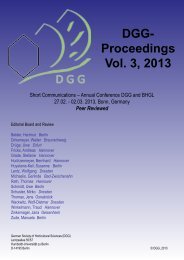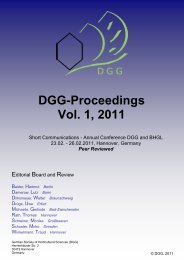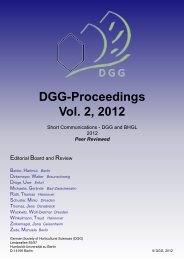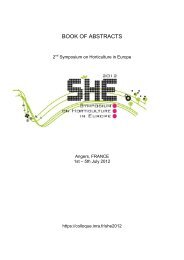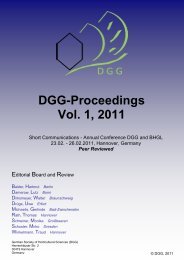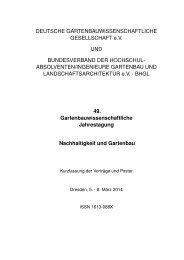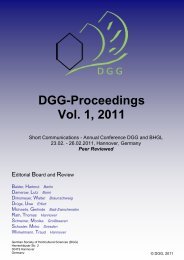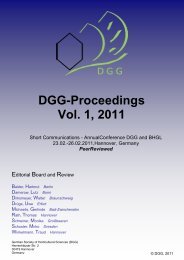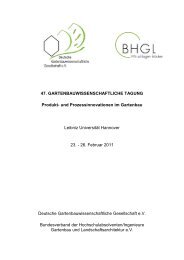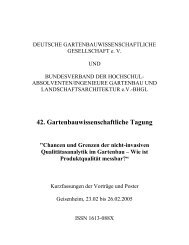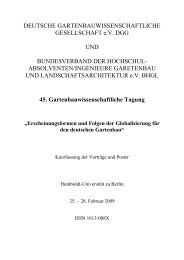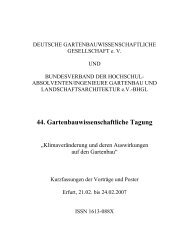43. Gartenbauwissenschaftliche Tagung - (DGG) und des
43. Gartenbauwissenschaftliche Tagung - (DGG) und des
43. Gartenbauwissenschaftliche Tagung - (DGG) und des
Sie wollen auch ein ePaper? Erhöhen Sie die Reichweite Ihrer Titel.
YUMPU macht aus Druck-PDFs automatisch weboptimierte ePaper, die Google liebt.
82<br />
Gemüsebau/Obstbau „Umweltparameter <strong>und</strong> Produktqualität“<br />
The Effect of Diffuse Light on Sweet Pepper, Tomato and Cucumber<br />
Production<br />
S. Hemming 1 , T. Dueck 1 and N. Marissen 2<br />
1<br />
Plant Research International, Wageningen University and Research Center, Bornsesteeg 65,<br />
NL-6708 PD Wageningen, silke.hemming@wur.nl and tom.dueck@wur.nl<br />
2 Applied Plant Research, Wageningen University and Research Center, Linnaeuslaan 2-A,<br />
NL- 1431 JV Aalsmeer, nollie.marissen@wur.nl<br />
In Dutch glass greenhouses light is not distributed equally. Fruit vegetables with a high leaf<br />
area index intercept a high quantity of light with the upper leaves, the lower leaves receive<br />
much less light and hardly contribute to photosynthesis and therefore to growth and production.<br />
If it is possible to shift light from the upper crop layer to the lower crop layer the<br />
photosynthetic efficiency of the whole plant will be increased. This can be realised by making<br />
all incoming light into the greenhouse diffuse. Greenhouse covering materials, which are able<br />
to transform direct light into diffuse light can be used for that purpose.<br />
A quantitative analysis of effects of the use of diffuse light on the growth and production of<br />
sweet pepper, tomato and cucumber in Dutch horticulture is given. The light-transforming<br />
properties of several (new) greenhouse covering materials are analysed and with the help of<br />
light models translated into potential amounts of diffuse light in the greenhouse. With the help<br />
of plant growth models the effect of diffuse light on light penetration in the canopy, light use<br />
efficiency of the crop, photosynthesis of the crop and crop production are analysed.<br />
Diffuse light is able to penetrate deeper into the canopy of crops with a high leaf area index.<br />
Especially during the winter months more PAR is penetrating into the lower crop layers. However,<br />
the crop is too small to intercept all the light. At the same time the amount of direct<br />
light, which can potentially be transformed into diffuse light, is low. Therefore it can be concluded<br />
that diffuse light seems to have no advantages during winter months. During spring,<br />
summer and autumn months especially the middle crop layers receive and intercept more<br />
PAR, when light is made diffuse. This results in an increase in crop photosynthesis and fruit<br />
production. During these months the fruit production <strong>und</strong>er a highly diffusing covering material<br />
is increased by 5-10% compared to a clear reference material. The production increase is<br />
depending on the crop, the light-transforming properties of the covering and the total light<br />
intensity.<br />
BHGL – <strong>Tagung</strong>sband 24/2006



